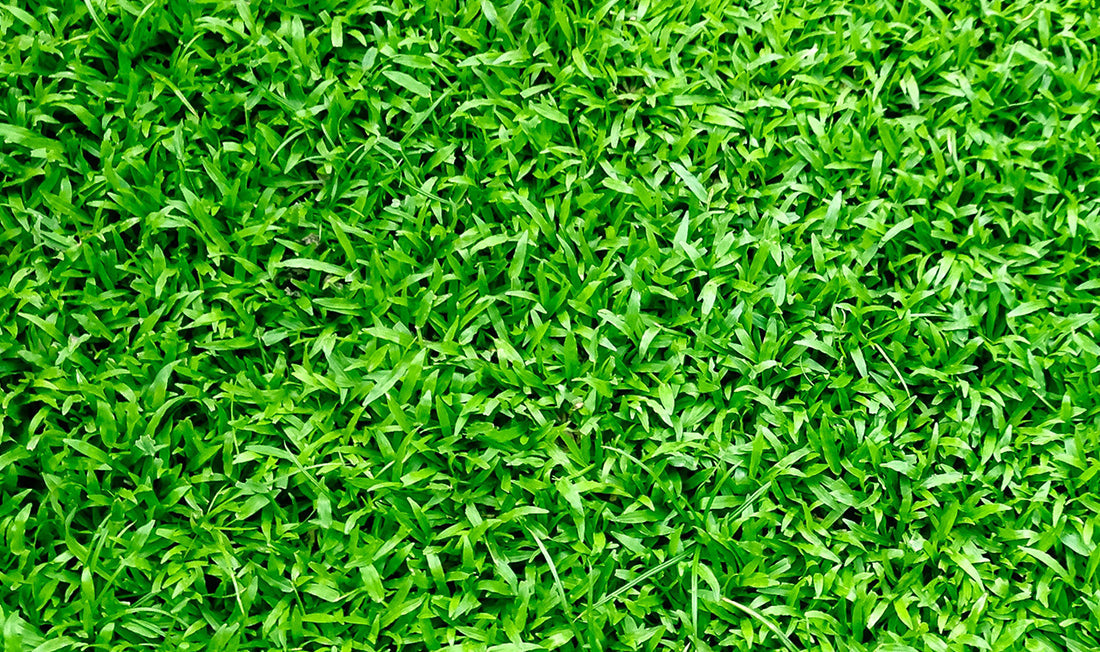Centipedegrass (Eremochloa ophiuroides) is a popular warm-season grass grown throughout the southern United States, known for its low maintenance requirements. So much so that this grass has earned the nickname “lazy man’s grass”. If this sounds like your kind of lawn management, keep reading as we’ll detail everything you need to know about centipedegrass lawn management.
Characteristics
Centipedegrass is best adapted for low-maintenance, low-use lawns. If you’re going to be out in your yard, constantly applying heavy foot traffic from kids, pets, and gatherings, we suggest choosing a different grass that will better hold up to this stress long term (bermudagrass).
Centipedegrass has a medium to coarse texture, and a natural yellowish, lime green color. It spreads by stolons, which are above ground stems that produce growing points (nodes) that root into the ground. Centipedegrass lawns can be established from seed, sod, or sprigs (pieces of stolons). Most of the newer, improved cultivars will need to be established vegetatively by sprigging or sodding. Centipedegrass is best adapted to infertile, acidic soils with plenty of drainage. Centipedegrass will not tolerate high pH soils, soils high in phosphorus or low in potassium, and compacted soils.
Centipedegrass has fair to moderate shade tolerance, requiring a minimum of 6 hours of full sun per day to look its best. It has moderate drought tolerance and should only be watered when signs of drought stress are evident. The naturally shallow root system can be encouraged to grow deeper by implementing a deep and infrequent watering schedule. The shallow root system and lack of rhizomes also makes this grass intolerant of extreme winter weather. Some of the improved cultivars have been bred specifically for enhanced tolerance of cold weather.
Fertilization
The most common mistake with centipedegrass lawns that leads to their long-term decline is over fertilization. Centipedegrass naturally has a low nutrient requirement. Excessive fertilization can lead to a reduction in cold tolerance and heavy thatch buildup. These two issues will result in a steady decline in the quality of your lawn over time. Never apply more than 2 pounds of nitrogen per 1000 square feet of lawn over any one growing season. If you’re trying to deepen the green of your centipede lawn, use foliar applications of iron with low nitrogen like SLS Darker Green or SLS Lawn Energizer.

Remember, with this grass, it seems the more you try to do to make it look better, the worse it will end up looking. Soil test yearly to make sure your soil pH is within an acceptable range. For centipedegrass this range is typically between a pH of 5.0 - 6.0.
Mowing
Centipedegrass is a relatively slow grower and shouldn’t require an extraordinary amount of mowing. It does look best when it is mowed pretty low, between 1 and 2 inches. Opting for the higher end of the mowing height spectrum can help reduce the frequency of mowing events necessary to eliminate scalping and will also help the grass tolerate a bit more shade. Mowing lower requires more frequent mowing to avoid scalping your grass. Make sure to use sharp mower blades to provide a clean cut that doesn’t fray the tips of the grass blades.

Irrigation
As mentioned previously, centipedegrass has a shallow root system. It also prefers soils that are pretty well drained. What this means for you is to turn off your irrigation until you see obvious signs of drought stress.

At this point, water heavily and not again until drought symptoms reappear. This allows the soil to dry thoroughly betweens waterings and can help reduce weed seed germination pressure as the upper portion of the root zone will not remain wet for extended periods.
Pests
Centipedegrass is susceptible to damage from various insects and diseases. Mole crickets, grubs, spittlebugs, nematodes, and ground pearls can cause significant damage to centipedegrass lawns. If you suspect damage is occurring on your lawn from insect pests, contact your local county extension office and ask them for advice on how to identify the insect and how to control the insect using a combination of cultural and chemical control methods.

The major disease of centipedegrass lawns is large patch (Rhizoctonia). This disease will typically occur in the shoulder seasons of spring and fall and is fueled by moisture. Fungicide applications in the fall when soil temperatures drop below 70 degrees F will help with control. A spring application may also be warranted, contact your local county extension agent for control strategies that work best in your area. Remember sharp mower blades and thatch reduction will help reduce disease pressure without the use of fungicides.
Weeds can be best managed using preemergence herbicides in the fall for winter annual weeds and again in the spring for summer annuals. Centipedegrass is sensitive to many common herbicides so make sure to read your herbicide labels prior to applying anything to your lawn to make sure that it is safe to apply.
All in all, a centipedegrass lawn will look great with plenty of sun, minimal fertilizer, and a soil pH below 6.5. Remember, it’s called lazy man’s grass for a reason, as the more intensively it is managed, the worse it seems to perform. Contact us today for a free centipedegrass lawn care plan custom tailored to your situation.









